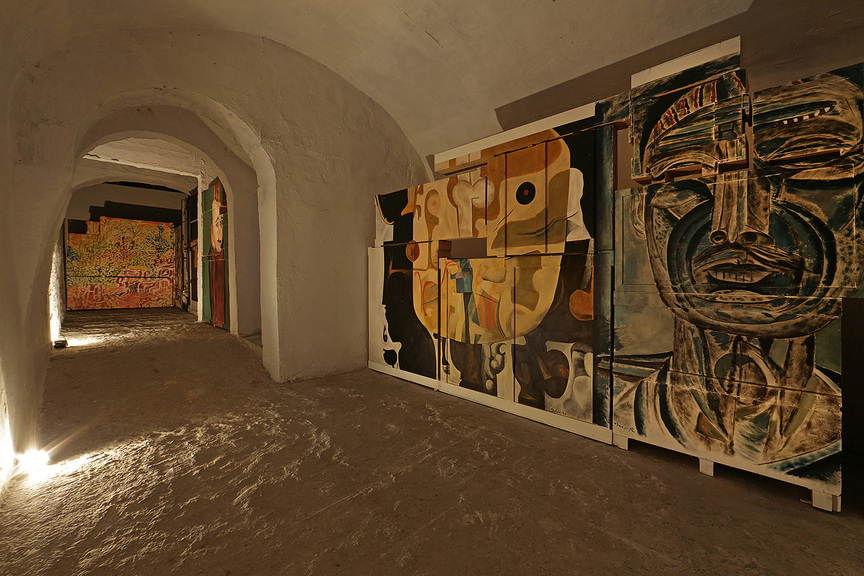-
From Current Issue
-
- Editor’s Letter Fire in the Heart
- Reviews I Gusti Ayu Kadek Murniasih
- Reviews 11th Seoul Mediacity Biennale: “One Escape at a Time”
- Dispatch Networked China
- One on One Monira Al Qadiri on Yukio Mishima
- Essays The rise of independent art spaces in pandemic-era Shanghai
- Features Tuan Andrew Nguyen
- Table of Contents
- Web Exclusives
- Archive
- Subscribe

R
E
V N
E
X
T
Installation view of WALID RAAD’s “Yet Another Letter to the Reader” at Fondazione Volume!, Rome, 2017. Photo by Federico Ridolfi. Courtesy Fondazione Volume!
Best-known for his long-term project “The Atlas Group” (1989–2004), which created fictional stories out of archival materials and fabricated documents to explore the contemporary history of Lebanon, Lebanese artist Walid Raad has since expanded the focus from his homeland to the wider Middle Eastern region in his ongoing project “Scratching on Things I Could Disavow: A History of Art in the Arab World” (2007– ). In “Scratching,” he delves into the proliferation of art infrastructures in the Middle East, during a moment of extreme geopolitical instability in the region.
At Fondazione Volume!, Raad lined the gallery’s walls with over 30 wooden transport crates to create a labyrinthine assemblage of paintings. These are copies by Palestinian artist Suha Traboulsi featuring works by major Arab artists, including Khalil Gibran, Ibrahim el-Salahi and Shakir Hassan al-Said. Following his “Postscript to the Arabic Translation” at Beirut’s Aïshti Foundation, and “Yet Another Letter to the Reader” presented at the 11th Gwangju Biennale, the exhibition purported to continue Raad’s collaboration with Traboulsi. Her paintings were placed side by side in no apparent order. Dim, yellow lighting in the hollow, arched setting bestowed the works with a sense of reverence. A range of styles emerged, paralleling developments in Western art, from Fauvism and abstraction to figuration and Post-surrealism. Particularly striking was Marwan Kassab-Bachi’s quasi-Expressionist 1965 painting of a mustachioed, balding man who looks at the viewer with a penetrating but dejected gaze. Another standout piece was Jafar Islah’s 1968 painting featuring a black rectangle wrapped on three sides by a field of nickel gray, with a smaller square at its center made up of brightly colored vertical stripes.
At the exhibition’s entrance, a wall text explained that the works on display were copies of canonical paintings by Middle Eastern artists that were originally acquired to form the core permanent collection of Lebanon’s first Museum of Modern Art, expected to open in 1975. The museum never launched, and the works remained in the depots of the Ministry of Culture in Beirut. Over the years, however, a number of the works were surreptitiously gifted by Lebanese political figures to family members, relatives and cronies. Suha Traboulsi, who was chief registrar of public collections in the Lebanese Ministry of Culture from the 1950s to the ’80s, helplessly witnessed the plunder. Traboulsi went on to faithfully reproduce the stolen paintings on wooden storage crates and shipped them to the countries where the works had been sent to, in the hope that one day the lost artworks would find their way back into the crates, and, ultimately, into a new Museum of Modern Art of the region.
The narrative formed around the works is a fictional one, as is the painter Suha Traboulsi, one of Raad’s recurrent and busiest avatars. Like all good tales, however, there is some truth to it. The Ministry of Culture does hold an art collection in a storage facility, and stories of illicit gifting have been circulating for years. The chronicles don’t appear entirely implausible, and at no point does Raad admit this is a fictional account.
As with most of Raad’s work, the installation raises complex questions without easy answers. He is concerned with how art and culture are affected materially—destruction, looting—and immaterially—trauma, loss of tradition—by the various wars that have consumed the Middle East over the past decades. In a conversation with the show’s curator Claudia Gioia, Raad elucidates how the paintings that are reproduced on the storage boxes, although canonical in the Arab world’s art historical narratives, are “not yet ready to be displayed in a museum.” The paintings in “Yet Another Letter to the Reader” exist in a precarious state as reproductions, not the originals that are yet to return to their crates. Thus, the original paintings’ absence can be construed both as an allegory of trauma and fragmentation of identity following a conflict, as well as a refusal to fit within a contrived art historical narrative that fuels the formation of art museums. This institutional critique becomes overt when contextualized in the frenzied building of arts infrastructures fuelled by petrodollars. Compounded by the wave of political violence that has plagued the Middle East, it begs the question: who will this hasty marriage of art history and finance benefit, and who will be represented in its quarters?
Walid Raad’s “Yet Another Letter to the Reader” is on view at Fondazione Volume!, Rome, until May 19, 2017.
To read more of ArtAsiaPacific’s articles, visit our Digital Library.






